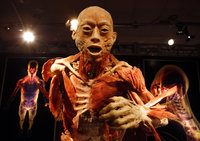The living dead exist for real
For centuries, people sincerely believed that the dead can rise from their graves. The most famous character is Dracula. In Lower Saxony, Germany, archaeologists found evidence to prove the existence of such zombies.

Legends about vampires and zombies accompany the literary history of mankind. Not that long ago, in the area of the town of Stade (a Hanseatic town in Germany, located in Lower Saxony, between Hamburg and Cuxhaven) a bizarre finding was made, which gave archaeologists reasons to think that they found something that proved the existence of the living dead.
Scientists came to conclusion that our ancestors were not trying to resurrect the dead. On the contrary - they were trying not to let the deceased rise from their graves.
Ludwig Strackerjan, a German national, has an extensive collection of superstitions and legends that he gathered in the duchy of Oldenburg. According to him, more than 150 years ago, the dead were supposed to be buried along with their clothes, a spoon and a needle, with which they could mend their ragged robes. As soon as the coffin would be taken out of the house, people would put down the fire in the hearth. Interestingly, the dead would be buried in fairly deep pits.
What if someone forgot to put out the fire in the hearth, or put a needle in the coffin? In this case, the living would face serious problems as the dead would rise from the grave, becoming a ghost or a zombie.
Archaeologist Daniel Nösler found something near the town of Stade that proved such practices. Demonstrating old photographs of excavations in the former monastery of Harsefeld, Nösler pointed to a strange boulder next to the skull. The large boulder crushed the skull of the deceased individual. As it appears, the boulder was unlikely to have rolled into the grave. It took the efforts of two strong men to remove the boulder from the remains.
"The soil at this cemetery looks like it has been sifted, there are not even small pebbles and gravel there," the archaeologist from Stade said in an interview with spiegel.de. The man also said that the soil in the area was of a slightly different shade than the ground found inside the grave. The boulder could not find itself in the grave incidentally. The grave had been unearthed after the dead had been staying there for a while.
Indeed, the undead is common in the folklore of Northern Germany. For example, there is a tale about a poor woman from Brake, who promised another woman to take care of her burial for 15 thalers. When the woman died, the other woman used the payment for her own needs, contrary to her promise.
The dead woman would then come to look for her money every night. In the end, the woman was declared outlawed, and the dead calmed down. This is a usual end for such stories, although, unfortunately, there are no details provided on to how the undead would be declared outlawed.
After Nosler told his colleagues about the story of the grave in Harsefeld, Dietrich Alsdorf recalled another curious burial that had been previously found in the area. Thirty-two years ago, in the western part of the cloister of Harsefeld monastery, a coffin was unearthed. The coffin had been buried in an unusual manner, with its lid down, the researcher said.
In addition, there were bricks found on the tomb, whereas the coffin had been buried deeper than usual. Someone definitely wanted to bury that dead person for sure, the researcher believes.
The two mysterious graves of the "living dead" are dated back to the XIV or XV century. "It was a time of large-scale epidemics, - explains Nosler. - If one died, he or she would often be followed by other family members. It was a widespread belief that the dead would grab the living and drag them into the nether world."
In medieval German legends, there were other types of undead creatures described - the so-called Nachzehrer (derived from a verb meaning extinction, loss, depletion or exhaustion of man). Those creatures were like vampires, but they were somewhat different.
If a piece of shroud would inadvertently find itself near the dead person's mouth, the dead would suck on it to obtain vitality and suck the lifeblood out from all those who had touched the piece of cloth before.
In the village of Oldendorf, located in the lower Elbe, Nosler and his colleagues found a Nachzehrer. In the burial from the XI or the XII century, an upper arm bone was resting across the neck of the dead. The bone, the researchers believe, was supposed not to let the shroud touch the dead person's mouth.
"Now we know that in these places, people did believe in the undead, and we will seek for more evidence," the researchers said.
Igor Bukker
Pravda.Ru
Read the original in Russian
Subscribe to Pravda.Ru Telegram channel, Facebook, RSS!


